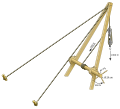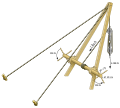Fitxer:Trispastos scheme.svg

Mida d'aquesta previsualització PNG del fitxer SVG: 665 × 599 píxels. Altres resolucions: 266 × 240 píxels | 533 × 480 píxels | 852 × 768 píxels | 1.136 × 1.024 píxels | 2.272 × 2.048 píxels | 1.520 × 1.370 píxels.
Fitxer original (fitxer SVG, nominalment 1.520 × 1.370 píxels, mida del fitxer: 117 Ko)
Historial del fitxer
Cliqueu una data/hora per veure el fitxer tal com era aleshores.
| Data/hora | Miniatura | Dimensions | Usuari/a | Comentari | |
|---|---|---|---|---|---|
| actual | 16:36, 17 nov 2010 |  | 1.520 × 1.370 (117 Ko) | Sting | Error correction |
| 01:17, 10 juny 2008 |  | 1.520 × 1.370 (117 Ko) | Sting | == Summary == {{Information |Description={{en|Scheme of an Antic Roman Trispastos crane.}} {{fr|Schéma d'une antique grue romaine du type ''trispastos''.}} |Source=Own work<br/> Based upon : Hans-Liudger Diene |
Ús del fitxer
Les 2 pàgines següents utilitzen aquest fitxer:
Ús global del fitxer
Utilització d'aquest fitxer en altres wikis:
- Utilització a ar.wikipedia.org
- Utilització a de.wikipedia.org
- Utilització a en.wikipedia.org
- Utilització a es.wikipedia.org
- Utilització a fi.wikipedia.org
- Utilització a fr.wikipedia.org
- Utilització a he.wikipedia.org
- Utilització a it.wikipedia.org
- Utilització a ja.wikipedia.org
- Utilització a nl.wikipedia.org
- Utilització a nl.wiktionary.org
- Utilització a pt.wikipedia.org
- Utilització a ru.wikipedia.org
- Utilització a sl.wikipedia.org
- Utilització a sr.wikipedia.org
- Utilització a zh-yue.wikipedia.org
- Utilització a zh.wikipedia.org


